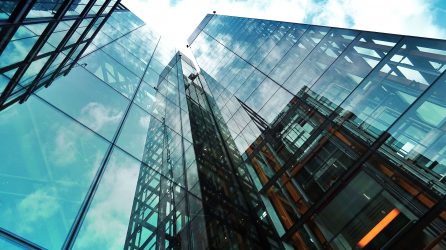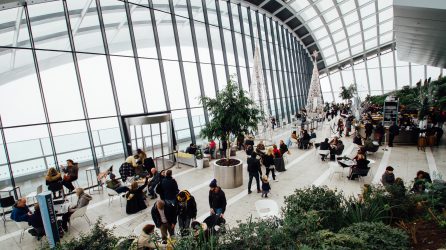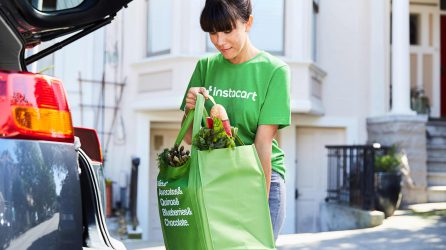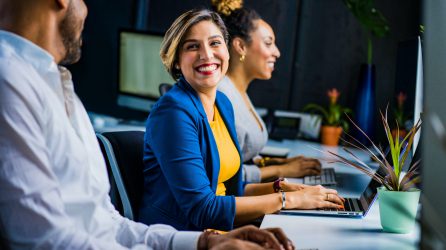The CPG post-pandemic outlook: 5 trends that will shape the industry #5

Presented by:
Josi Mathar — 2021
These CPG post-pandemic trends will shape the future of the Digital Shelf
In this episode we’re looking to answer one central question: what comes next?
As we emerge from the pandemic, what’s the CPG post-pandemic outlook? What will shopper behaviour look like in the new normal? And what are the implications for online buying and eGrocery in particular?
To help us answer these questions, we’re joined by two fantastic experts from the Consumer Brands Association: Ellen Davis, Executive Vice President for Industry Engagement and Katie Denis, Vice President for Research and Industry Narrative and also author of a fascinating new report called The CPG Post-Pandemic Outlook of which findings have guided our discussion.
“The pandemic really accelerated the adoption of consumer online shopping behavior in commodity type categories which is where CPGs really play” Ellen Davis, Executive Vice President for Industry Engagement
📝 The Show Notes
Julia and our guests discuss the 5 trends that have emerged from the report which is based on an Ipsos poll of 1,008 American adults and conversation with CPG subject matter experts. At the end of the show our guests give their one essential advice to listeners, their #20secondsmarts

5 eye-opening CPG post-pandemic trends and the questions we asked
- Product demand stays elevated (06:15): CPG demand is expected to remain high long after the vaccine is widely available. The survey found nearly half (47%) of consumers said they used online ordering for delivery or click-and-collect services during COVID-19. Of those, 77% plan to continue using them after the pandemic. How is the industry adapting to this huge shift to online? What reactions did you get from CPG brands to your forecasts around ecommerce specifically? How are they adapting?
“The biggest seachange will probably be the remote work revolution. Our survey showed 82% of people want to continue working remotely in some fashion. That’s going to change the dynamics of how and where people consume. It’s been a huge driver for the incredible demand we’ve experienced over the year and that’s going to keep levels elevated in some fashion for the long haul” Katie Denis, Vice President for Research and Industry Narrative
- Supply Chain Innovation (15:12): Grocery chains were thrust into the spotlight during the pandemic when those huge spikes led to empty shelves and shortages. While disruptions were temporary and overall grocery supply chains coped remarkably well, they were enough to prompt questions in many consumers’ minds. What are consumers looking for now in this area, what questions are they asking – and what does this mean for CPG brands? What are some CPGs innovations around supply chains that look to build consumer trust? What kind of organisational structure will help brands do well in this context? What will differentiate winners from losers?
- New Urgency to Fix Broken Recycling System (24:03): As the pandemic took hold of the world, plastic consumption skyrocketed as environmental concerns took a backseat. How have consumer attitudes to sustainable packaging and recycling changed post-Covid? And how do you [the CBA] see the industry responding to this immense challenge?
- Digital Transparency Accelerates (33:38): Transparency has long been important in grocery but the pandemic has raised the stakes. US consumers now rely on the digital shelf more than ever with 57% of consumers saying they have greater trust in companies that offer more information than is required about their products. What kind of information are consumers looking for? And how do brands best provide that information? Through extended product descriptions on retailer ecommerce sites, on their own websites, through QR codes, on social media?
- Companies Become Societal Change Agents (40:05): The pandemic accelerated the expectation that business should take a stand on societal issues and become a force for good. The report finds the trust in companies that grew during the pandemic will result in businesses becoming societal change agents. What are the implications for brands preparing for a post-pandemic shopping landscape. How can brands talk about product features as well as values? As a CPG leader how can you look to make your company a force for good? What are some of the internal changes that need to happen to achieve desired results?

📲 References and People mentioned in the CPG post-pandemic outlook episode
- CPG Speaks
- Mark Clouse, CEO Campbell Soup
- Betsy Booren, Ph.D. Senior Vice President, Regulatory and Technical Affairs, Consumer Brands
- Tom Madrecki, Vice President Supply Chain and Logistics, Consumer Brands Association
- OxiClean, Church & Dwight, Proctor & Gamble, Kellogg's, General Mills
- Clorox, Reckitt, Smuckers, Starbucks
- Amazon.com, Gap, Macy's, Instacart, Walmart, Target, Costco
- National Retail Federation, Recycling Leadership Council
- Edelman Trust Barometer
- Free ecommerce readiness consultation
🎧 Missed our previous episode? Listen here to Winning in Ecommerce, Eps.4
Abbreviated Transcript of the CPG post-outlook, Eps. 5
A quick note on the legal conditions
e.fundamentals owns the copyright to all the content in The Digital Cast podcast and the transcripts, with all rights reserved and our rights of publicity.
We’re happy for you to do the following
Feel free to share up to 500 words of the episode’s transcript in media articles (The Grocer, Financial Times or the Guardian), on your personal website, in a non-commercial context such as an article or blog post (e.g. Medium), and/or on a personal social media account for non-commercial purposes, provided that you include the attribution to “The Digital Shelf Cast” and link back to the efundamentals.com/podcast. Media outlets with advertising models are permitted to use excerpts from the transcript as per the above description.
What we’d like you to refrain from doing
It is not allowed to copy any portion of the podcast content or use e.fundamentals name, images or likeness for any commercial purpose or use, including without limitation inclusion in any books, e-books, book summaries or synopses, or on a commercial website or social media site (e.g., Facebook, Twitter, Instagram, Linkedin etc.) that offers or promotes your or another’s products or services. Media outlets and journalists are permitted to use imagery from e.fundamentals. Please contact [email protected]
Thanks!
Julia Glotz: In today's episode, we're looking to answer one central question. What comes next? As we emerge from the pandemic, what's ahead for CPG? What will shopper behaviour look like in the new normal? And what are the implications for online buying and eGrocery in particular? To help us answer these questions, I am joined by two fantastic experts from the Consumer Brands Association. Ellen Davis is Executive Vice President for Industry Engagement, and Katie Denis is Vice President for Research and Industry Narrative, and also author of a fascinating new report just issued by the Consumer Brands Association, which will guide much of our discussion today.
Now before we dive into your report, I'd love to just quiz you a little bit about your own online shopping habits. So Ellen, I'm going to start with you, tell me about the last item you purchased online. Perhaps tell us a little bit about what that experience was like.
Ellen Davis: Increasingly during the pandemic. I feel like I'm buying different things online than I used to. But the most recent thing I purchased online were some Easter presents. So that feels pretty normal to me. But increasingly food and laundry detergent and all sorts of things that usually you'd go to the store to pick up.
Julia Glotz: And Katie, tell us a little bit about your online shopping habits and how they've changed perhaps over the past year,
Katie Denis: I'm buying very different things online than I was before. I think my last Amazon cart was Oxiclean and soccer equipment. So it's getting a little wilder as the pandemic wears on with the things that I would otherwise run out and buy that I'm willing to just throw in a cart now.
Julia Glotz: Fantastic, let's turn it to your report and perhaps dive into some of these interesting new pandemic purchasing habits in some more detail. Your report is called the CPG post pandemic outlook. And it sets out five key trends emerging from the pandemic that will fundamentally shape the CPG industry in the months and years to come. We will touch on all five of these trends on the show today. But before we do so Katie, could you just briefly tell our listeners about the report and the methodology behind it? What are the trend predictions based on? And why did you decide to write this research?
Katie Denis: The last year has been a complete wild ride for the entire world. From the CPG industry's perspective we have seen incredible demand, which has meant incredible change. And so much of this is about acceleration of things that were already happening, but acceleration at a rate that no one could have predicted. So what we wanted to do was look at what has happened over the last year and determine how that's going to affect the year ahead.
We're looking at this in a different way. We're not necessarily talking about SKU numbers and rationalisation or things like that. Things that are also trends we've certainly read about, but from our perspective, we're looking at what are some of the policy changes? What are some of the things that are going to have to accommodate the world and where it's going for CPG?
Julia Glotz: And just talk a little bit about the methodology: how did you do the research for this report? What are some of the predictions based on?
Katie Denis: The methodology for this report was a little bit unusual from our normal. We took a few different things into mind. One, what are the economic numbers telling us about demand and the demand picture going forward? We also did a survey and opinion poll of 1000 American adults and just said what's your gut on this? What do you think about this? What's your reaction to inform a lot of what we were doing? And then we took those kinds of two data points together, and put some of the questions to our internal experts.
Consumer Brands has a number of experts on staff from everything from packaging and sustainability to supply chain to Ellen's area, we've got a lot of insights so let's take the experts to really draw out what these numbers mean, and not just what they mean for the last year, but what will they mean going forward.
Julia Glotz: And then just a little bit of extra context for listeners. Could you just spin out who the consumer brands association is and what it does?
Ellen Davis: The Consumer Brand Association represents the entirety of the consumer packaged goods industry, with companies primarily in the US, although we do have some multinational businesses as well. We've got a lot of food and beverage companies like General Mills, Kellogg’s but we also have a lot of health and personal care companies like Procter & Gamble and Church & Dwight which is Katie's OxiClean. And we also have a number of cleaning products and household cleaning companies like Clorox and Reckitt. So we kind of think about the issues that are bringing the entire industry together, not specific to one certain category in the industry.
Julia Glotz: Now, let's turn to the first trend that you identified in your report. And this is all about product demand. And Katie, you touched on this already, when you describe this “wild ride” that 2020 was for much of the CPG industry.
One of the big questions that lots of CPGs have at the moment is about what's going to happen with demand, because we saw those huge spikes, particularly in spring 2020, which then settled down a little bit, but they've remained elevated. But now that restrictions are being lifted and vaccine programmes are being rolled out how much of that elevated product demand is really going to stick? Can you just talk us through what did you research uncover? And therefore what should CPGs expect in terms of product demand over the coming months?
Katie Denis: So no one can prepare for a 21% spike in demand. It is impossible. That just doesn't happen. Wildest fantasies biggest product launches, 21% for an entire industry to spike in one month is crazy. But one of the things that we saw from the survey that I found really interesting was when people anticipate the pandemic will be over in their minds. What does that exactly mean?
I've done a lot of survey research in my life, this has been really a decade of looking at opinion surveys and feeling like I can predict what people are going to say most of the time. This one, it wasn't what I thought the majority would be. So I was way off where I figured most people would say, when a majority of Americans are vaccinated will kind of get back to normal, and then the pandemic will be fundamentally over. And that was what 12% of people responded to. I was really surprised to see that a third said, Okay, yes, when enough are vaccinated, and then time has passed. So I know for sure it's safe. That was our most dominant response. But then another third said, it's never really going to be over which I found really surprising.
So all that to me, signals are reticence that people are not going to, you know, just go back to what they were doing before. And that was kind of the premise of a lot of this report, there will be no return to normal normal has been totally redefined. We might get back to some of our spending patterns, we might get back to some of what we deem as normal, but I think we are fundamentally changed as people. And that's going to be something that plays out. So we have this kind of slow, we're getting back into the groove of things that I don't really expect that people are going to be jumping to go out to restaurants to go out to concerts, events, but I do think that it's gonna be a little bit more of a tiptoe back, which will keep demand for the industry high.
The other thing is, we do have some permanent changes. And I think this is really the most fascinating part of it. Because ultimately, we know that we're going to stabilise to some of our activity patterns, we will eventually go back to concerts and stadiums and travelling.
So what are the permanent things? To me, you've got stuff where we had someone from Smuckers on CPG Speaks, which is a series we do to look at perspectives from industry leaders, and they were talking about how there were 11 million pets that were brought home during the pandemic and some number of millions of coffeemakers. I mean, these are lifestyle changes that aren't going to go away because the virus does. So I think that's something we need to factor in.
But the biggest sea change is probably going to be the remote work revolution. You know, whether this comes in a massive drove like some people have predicted or even marginally, our survey showed 82% of people want to continue working remotely in some fashion. So at least one day a week, that's going to change the dynamics of how and where people consume. And that has been a huge driver of the incredible demand we've experienced over the last year. So to me that's going to keep us elevated in some fashion for the long haul.
Julia Glotz: I think that's fascinating and actually jumping on some of what you've just said, you know, when we think about some of the longer term changes is obviously that shift to online is one of those those shifts that we're expecting to be longer term as well, there were a couple of stats that I thought were really fascinating. In your report, your survey found nearly half of consumers said they used online ordering in some form during COVID. And of those 77% plan to continue using those services after the pandemic.
Ellen, I'd love to bring you in on this a little bit. Because this is obviously a huge shift online, we've talked about this quite a lot. It's one of the defining themes of the pandemic. How is the industry adapting to this? What reactions Did you get from some of your members, some of the big CPG brands that you work with, to some of your forecasts around ecommerce specifically.
Ellen Davis: Everyone's different, everyone's definition of online is so different. I'm actually sitting here drinking Starbucks that I ordered with an app on my phone this morning. And that's my latest online purchase. But a lot of times, part of the issue is when we say online, we think about going online to Amazon. In the US we think about buying something from the Gap or buying something from Macy's, we're not necessarily thinking about click and collect or Instacart, or your Starbucks app. All of that is ecommerce, all of that is digital.
During the pandemic, all of that was behaviour that consumers were continuing to adopt and accelerate, adopting in order to feel safe and healthy, and still get what they need for families. What's interesting about this shift is, before joining the Consumer Brands Association, I spent over 15 years with the National Retail Federation, and I saw consumers in the early 2000s really start to adopt behaviour of buying things like books, electronics, clothing online. And if you look at the saturation of those categories, it really continued to elevate and was pretty high. What we always said was, at the time, people are still going to need to stop by the grocery store to pick up Tylenol and pick up milk and pick up laundry detergent, because it's convenient. It's you know, items that you tend to run out and without necessarily thinking about in advance, you know, for a two day delivery, and COVID changed all of that.
COVID really accelerated adoption for digital behaviour of consumers in those commodity type categories, which is really where the CPG industry plays. So if you think about 18 months ago, people weren't really thinking about buying yoghurt, cereal and OxiClean and other things online, whether that's through Target or Walmart click and collect or through Amazon or having somebody delivered through Instacart.
Some companies in both retail and CPG had seen this coming and were more ready for a consumer that wanted to drive into a parking lot and have somebody put something in their trunk, some companies were not. And if you think about CPG, a lot of the consumer behaviour that they have leveraged over decades, has really relied on the store experience where an item is placed in the stores e.g. in the end cap where you might be standing in line for checkout, and the cereal at the end of the aisle versus in the middle was an part of the show in the middle of the shelf.
In the US, everybody goes to Costco on Saturdays to sample all the food, you don't have that duringCOVID. And you don't have that now with consumers really kind of leisurely wandering around to try out pizza or hotdogs or ice cream. So how, as a CPG company, then are you introducing consumers to new innovations when they kind of want to get in and get out or buy online and pick something up in the parking lot. So those are all very different behaviours that companies are thinking about how to work out how to get this product to consumers safely and easily. But also, how do I encourage them to try and learn new product innovations and new categories that maybe they hadn't experienced before. So it's really led to huge sea change.
There is such a convenience factor here that is at play so it's going to be interesting to see how a lot of this moves forward. But it's something CPG companies are grappling with pretty strongly right now.
Julia Glotz: I think the point there about product discovery is interesting, particularly now that in store browsing behaviour is obviously not what it used to be. And we've talked on the podcast on previous episodes about the challenge around activating new innovation in the ecommerce environment that's very much a work in progress.
Let me bring you on to the second trend that you identified and that is supply chain innovation, which doesn't sound massively consumer facing on the face of it, but what you spelled out in your report is that Because grocery chains were thrust into the spotlight during the pandemic, and we saw those huge spikes in demand, and as a result had some empty shelves and shortages, certainly early on in the pandemic, those shortages, that experience of the disruption prompted questions that many consumers minds, and that has interesting implications for consumer trust and the value consumers now face, well functioning, seamless supply chains. Explain to us what this means in practice. What are consumers looking for when they're asking questions? And what questions are they asking about supply chains.
Ellen Davis: Supply chain was an issue that we began focusing on before COVID, but was probably never more important than at the height of COVID. And really, what a lot of our supply chain work boils down to is the ability for CPG companies to keep workers safe, while also continuing to be able to keep products on the shelves. What consumers want is that when they go to a store, or they go to an app, or they go online, the product that they're looking for is easily accessible and available. I think consistency and reliability are the really characteristic traits of the supply chain. And increasingly, it's a highly complicated part of the business. But it boils down to making sure that consumers have products.
Katie Denis: I think what's interesting about this, if I said supply chain 18 months ago to my mother, she would have no idea what I was talking about. In sales and marketing, now you can make a table conversation. And that represents an opportunity. And it's going to get some new innovation, and an opportunity to push things with the government or the charity for helping create a more frictionless supply chain.
I think it's also an opportunity within companies here we talked about a lot of the acceleration and a lot of the things that were happening with ecommerce, all that stuff is dovetailing at a time when companies are completely reevaluating top to tail their supply chain. So those two dynamics play together, basically what companies need for their own distribution. I think you're gonna see massive change that's going to ultimately make it a much smoother supply chain and a much more reliable way to make sure that people get what they suspect fashion going forward. We don't have great visibility for the supply chain at the federal level, I think that's something we've called for very aggressively. Companies are obviously constantly trying to improve supply chains, but it used to be more of an efficiency equation. Now, I think it's about resiliency. And that's a total mindset shift that I think is something we'll see carried into the next decade.
Ellen Davis: We also saw on the supply chain side, there was exposure to how much needs to come together, accurately analytical products you can do so especially at the height of COVID. If you're selling beer or big beans or soup and you can't package the product because you used to sell it to restaurants and now you're trying to put it in individual containers that changes your equation. Same with ingredients. A lot of our cleaning companies were having real challenges sourcing what they needed to produce disinfectants and wipes and so much like Katie was saying There's a role for the government to play here. But it's also really exposing other elements of the supply chain that are necessary in order to get consumers what they're looking for.
Julia Glotz: Just listening to both of you, the question that raises in my mind is, to what extent does your research suggest that consumers are looking for granular information about how supply chains are height? Is the consumer interested in the supply chain? To the extent that they just want to be assured that the products they want to buy are going to be available whenever they need them to be available? Or is there a greater level of interest in how supply chains work some of that sort of granular storytelling that companies perhaps might want to do?
Katie Denis: I don't think consumers are concerned about the supply chains inner workings, and I don't think they want to be concerned with them. If anything, that's what we've seen, what they realized is that there is potential exposure, and it's not something we've really faced before you see it when there's a snowstorm, or some kind of thing like that, where the bread and milk is gone. And local news, they go and they cover it right, that's our extensive knowledge of the supply chain prior to the pandemic. But the inability to get toilet paper or paper towels, or disinfecting wipes, or you know, some of the things that we saw throughout the pandemic, there's definitely a near majority that says, I'm gonna stay stocked up on that going forward, I don't want to be caught without, there's still that lingering feeling and a little bit of that concern, we're looking at around 45%, for a lot of those high demand items of people who say, Yep, I'm gonna stay stocked up, I just don't want to be caught without paper towels in my garage.
I think we're going to go back to that invisibility, where consumers don't have to think about them and things were just on the shelf. And really, that's what drove trust in the industry. We were measuring trust throughout last year. And what we saw is consistently rising. So people had pretty good stable trust in the CPG. industry. When we started early on, you know, we got about 37% of people saying they had more trust in the industry, and that consistently, every single time we measured it through, and I think that was because we went from empty shelves and panic early in the spring, to everything came back in. And it didn't really fade away even in November when we had a few hiccups.
What we found was we learned a lot of lessons in the spring, that we didn't have to have any shortages that were a real consequence in November. And that was in part because the CPG industry was incredibly creative and flexible, and throughout long honed algorithms and really said “okay, we have to do direct to the retailer, we can figure out channels to make sure stuff gets where it needs to, I mean, overtime hours, 24, seven production, it has been a grind.” But they figured it out to make sure people get what they need. And the retailers to their credit, started putting limits on high demand items when they started seeing things take off. I know that can cause a panic when people see that. And that was actually a really outward behaviour from what happened in spring. So I think as long as we don't see that stuff again it'll go back to being things that people don't have to think about. And I don't think they really want to know much more than that.
Julia Glotz: The third trends that you focus on in your report is all about recycling. And we've obviously seen quite a few changes around attitudes to plastic consumption during the pandemic, because understandably, environmental concerns to permit a bit of a backseat and plastic consumption increased. But I think it's useful to get an understanding of where we are now, now that you know, we're starting to emerge from the pandemic, what are you seeing in terms of healthy female attitudes to sustainable packaging, liking, in particular, are changing post COVID. Ellen, I'd like to come to you on that. What are you seeing? And what are the expectations for consumers like at the moment around this?
Ellen Davis: I think at a high level, what we're seeing what we saw during the pandemic is, to Katie's point, people were looking to consume the items that they needed that they could find, and that was the most important, what is interesting, and what we have heard is that eating more meals at home, having more packages shipped to your home, made you realise when you were kind of putting out your trash or your recycling every week, how much packaging do you actually have and what is in that packaging? And so it seemed to be this great aggregator where everything was being consumed at home, everything was also being thrown away now. And unlike going to restaurants and being at work and being at a concert, you got a real appreciation for what types of packaging your family was consuming and then needing to dispose of, and it really helped give us a sense of what we see as a broken recycling system in the inconsistencies that account for where in the US you can recycle certain products or not because it is plastic, but it's also glass and aluminium and cardboard, and all sorts of other things that in the US leads to a very fractured system and a very confusing system for people. So even if they are interested in making sure that they are disposing of items in the most environmentally friendly way, it can be awfully confusing to figure out how to actually do that. Katie, did you have anything to add there?
Katie Denis: Sustainability has stayed important to people throughout the pandemic; you still have numbers in the 80s of people saying “yes, I'm concerned about single use plastic”; ”yes, I'm concerned about the environment that didn't slip a little during the pandemic”. We normally see things in the high 80s versus the low on that. And I think the more telling number was seven in 10 people said, hygiene and my health is going to take priority over the environment right now. And that was really the sense of the moment, in many ways.
But I think that is a very short term feeling. As we come out of this, we're going to see that environmental concern and those behaviours creep back up. And to me, what's telling about that, is we asked about how much are you willing to pay for more recyclable packaging. And people aren't really willing to pay more for that, because it's table stakes. Now, I think that there's an expectation that they'll be able to recycle the packaging around products. And I think that there's some value in that too, because it just shows that this is very much part of the vernacular of consumers now that they expect to be able to recycle things. It's also part of the problem Ellen was getting into. They expect to be able to recycle things.
But I think the question we have to face is, where can they recycle them? In the US, we have nearly 10,000 systems that all get to have their own rules. You know, I lived in Virginia before where you could recycle a pizza box, I moved to Fairfax County, Virginia, which is still Alexandria, technically, you would not recycle a box here. And I'm literally three miles from where I used to live. But actually, I found out there are 15 different carriers in Fairfax County. So you have to call your specific pickup person to find that out. So ultimately, if you're a consumer, most people are not going to take on the burden of that level of research to find out what they can and can't recycle. And that's going to continue contaminating our recycling. And what we don't want is usable material to be tossed out landfills or end up you know, worse and oceans are rivers. And that's something that this country absolutely wants to address, and need to do soon. And I hope that as the environmental concern starts to perk back up as we move out of this pandemic, there will be more of an impetus to take action.
Ellen Davis: You've seen a lot of CPG companies making tremendous environmental commitments and commitments to their own packaging, that is going to lead to more recyclability, smaller footprints, lower emissions. And so there is not a disconnect between what consumers expectations are and what company's expectations are. Companies are doing what they can, especially CPG companies to be tremendous environmental stewards. The challenges, if you're trying to create a package that complies with those 10,000 different recycling systems, it's a huge jigsaw puzzle, and it's changing every day. And so that's where the consistency or lack of consistency is a problem for a lot of the companies we represent.
If you reduce the amount of packaging, you're organically reducing the amount of material that can be introduced to the environment. The problem with this that we found in the survey is that when you reduce the size, the package, the working assumption of most consumers is they're getting less, same price for less, they're getting less overall. And I think when you're shopping online, you necessarily have to see that shelf difference. There's an opportunity potentially, to overcome some of that mindset that I think could be helpful, overcoming mindsets on what packaging should be, I think it's going to be really key to what we can do going forward.
Consumers will have a very important role to play, they're not going to be able to drive the change about something we're fully aware of. But as the industry is looking at what it can do, whether it's reducing packaging, whether it's paying into a system to make sure that we've got the right recycling infrastructure, whether it's standardisation of what the rules are, all of that needs to be driven elsewhere. But consumers do have a really important role to play in terms how they perceive and act in their own homes. And I think that was something COVID really put on display.
Julia Glotz: You answered exactly the question I was about to ask you, which was about the finding that sometimes consumers can jump to that conclusion that manufacturers reduce packaging sizes, make them smaller or lighter. It's actually because they're out to increase their profit margin. They're doing the right thing for the environment. So it was interesting what you said about how ecommerce could help overcome some of that. Do you think that manufacturers would still need to be transparent about it? Like they will talk about transparency in a moment in more detail as well? Should this spell out that someone is still getting a smaller or lighter pack? Or do you think that consumers begin to accept a different pack size when they're buying online.
Ellen Davis: I think they have spelled it out. Actually, sometimes when they try to do the smaller sizes, they'll put it right on there, use that marketing space on the front of the package to say, new package, new size, but same amount. And I think, if it is sitting next to something that is a comparable product from another brand, that is a bigger box, there's an automatic assumption, that bigger box means more. So I think that's where the retail shelf is somewhat limiting. Here, you kind of have to get the entire aisle to conform if you want that consumer advantage to be the same playing field.
Online, you're looking at it in a different way. So I just kind of wonder if that's an area where people wouldn't necessarily feel like “oh, this must be less, because it's smaller.” I think it's these kinds of small changes that we can make that can all ladder up into something much more significant. So I don't want to focus too much on the fact that less packaging is the silver bullet solution. Recycling is not a silver bullet solution. But I think taken together, we can start to have a real impact. And a lot of this stuff is, hopefully the lower hanging fruit, that we can make some real change and have some quick impact.
Katie Davis: You also see a lot in the household cleaning space, specifically and some of that health and personal care, where you see completely different innovation as it relates to concentrated items, for example, where you might have a small package, and then the consumer needs to add water or refillable packaging, where you've got, you know, dish soap, and instead of buying the hard plastic container, you buy a more environmentally friendly container that you can pour into your plastic container that you already had.
These are the types of innovations in addition to packaging and packaging size that companies are leading forward where consumers are saying, “look, I'm willing to put a little bit of my own elbow grease into making sure that I can be playing my part in an environmentally friendly household or world because I will buy this refillable space, add water to something in order to make sure that I have the full amount versus having to have a huge package that's just water added already to it.”
I think what we're getting into as well is that there are so many silos to innovation right now. And one of the reasons consumer brands launched the Recycling Leadership Council was because we need to remove these silos if we're going to have a massive impact. And that, to me is like the biggest thing that we need to overcome going forward is the CPG industry can innovate and come up with like, crazy cool packaging, whether it's biodegradable, whether it's you know, creating a plastic that feels like virgin, but isn't and behaves like virgin plastic, but isn't. I mean, there's all sorts of cool innovations going on. But I think that innovation has to be paired with a system where one can process it. So that's where we brought all these different walks of industry and government groups together, because if we don't work together, we're all doing a lot of work. That's not going to have the impact it should.
Julia Glotz: You both raise really interesting points about some of the opportunities to create greater transparency, or tell slightly different stories or provide consumers with slightly more granular levels of information when you are selling through e commerce. And the fourth trend is all about digital transparency. Obviously, we've talked about transparency for a long time in grocery, but the pandemic certainly seems to have raised the stakes.
And Katie and Ellen, you've both talked about this in the context of recycling, but also supply chain transparency, as consumers now rely on the digital shelf more than ever for product discovery and product information. What are some of the opportunities for cpgs to use their apps to provide more granular product information? What kind of information are consumers looking for that they are perhaps not readily able to access in an instal environment?
Katie Denis: I think we've got a situation where there's been some resistance to the online label that can take you beyond what's on the physical label. The pandemic forced us all into a virtual world. And that alone is going to say, yeah, we've got enough people who know how to do this, it is part of their digital fluency now, so some of those barriers I think will come down. And that I think, will open up the possibilities here. I think the possibilities right now are very nascent, what's possible to learn versus what's wanted.
There's a divide there, where we might not need to offer exceptional granularity of the information we could put forward. So what does matter to people? And I think that's something we're still honing in on in what is going to inform what happens next. Because in many ways, the government has a lot to do with labelling and what goes on the package. So the idea that you can put more robust information via a QR code or some kind of link has been something that there's been some reticence to in government. We've seen the door open just recently in some kind of meaningful way with a lot of things that have happened with USDA on bioengineered disclosures, and then EPA recently said, we could allow disclosure of some ingredients via QR code. But this is just the beginning of the door opening.
There's tremendous possibility going forward for what digital closure should be. Our lead of regulatory affairs said, “in five years, it's going to be ridiculous, we were even having this conversation”, which I thought was very telling. And I think she's absolutely right. I'd love to check in on this in five years. But I think that this is the way we are all going. This is the way government needs to let us go because people want information, and they don't want the same information. So this allows for independent individual consumers’ needs to be met in a new and different way. Ellen, maybe you could talk a little bit about Smart Label.
Ellen Davis: I think the physical label itself is only so big, what you can put on your website about a product is endless and limitless. And so what this does, in addition to increasing transparency, it increases the potential for discovery. I mentioned I was at the National Retail Federation for a long time. I remember in 2005, all of these companies were having conversations about customer reviews, like I don't want to have customer reviews, I don't want another customer to know that my backpack, you know, might break or what other consumers are saying about it. The same could be true with CPG. When you are going to find information about a specific new product or brand or category for yourself, it might be interesting to see what consumers say about this type of yoghurt versus that one. And that's a totally new frontier for us.
The other element that I think is becoming increasingly important here, as it relates to digital transparency, really gets back to sourcing. So you have a lot of consumers now who are very interested in where ingredients inside of their products come from. There's been a lot of news lately about trying to create a carbon label for companies to help demonstrate and articulate the footprint of what went into making a product. There's also a lot to know, whether it relates to specific ingredients, where were they sourced? How are they manufactured or harvested. So, there's a lot more you can share for very curious consumers, especially on the sustainability front, as it relates to what you can share online versus actual labels.
We do have a marketplace solution at Consumer Brands called Smart Label, which many of our member companies use, it has a QR code either on a company's website or on the product itself, which allows consumers to easily access more information and they'll be able to find it on the physical label. This could be sourcing and ingredient information, it could be allergen information, it could be, in some cases, manufacturing information, could be consumer reviews for those who are kind of ready to go there. But that really gets to the sense of companies wanting to provide more information to consumers, especially those who deeply care about the issue or need to care. So if you're a parent of a child with allergies, you want to find as much information about products as you possibly can. The label is never going to get you everywhere that you want to go, but a website might. And so you've got a lot of companies that really recognize where their consumers are in this space, and are trying to accommodate all the questions that they have.
Julia Glotz: I suppose it sort of ties in quite nicely to the fifth and final trend that you highlight in your report, which is business being a force for good and taking a stand on important societal issues. I guess, if you do that, you also then want to make sure you put across what you're doing clearly and reliably, as Katie says to consumers as well. Ellen, I'd like to stay with you on this actually, because there's a fantastic quote in the report from you about what you're seeing happening within CPG businesses around this sort of whole issue of doing good and being a force for good. And what you say is that “you talk to CPG leaders every day and they are increasingly committed to being a force for good.” You add, “expect to see holistic changes, not just the product, not even just the company change will extend to anywhere business touches.”
As a CPG leader listening to this, if you're thinking about well, this is something that I need to wake up to advance to something where we're going to be increasing consumer expectations. How can you look to make your company a force For good, what's a good starting point? And what are perhaps some of the internal changes that needs to happen to deliver on some of those missions.
Ellen Davis: There's so much to unpack here, there's so many different ways that you could go, what I think many CPG CEOs are kind of beginning to recognise is that expectations for brands are different today than they were even a couple of years ago. It is not just about selling a great product that is easy to find. And it's not just consumers expectations that are changing, it is employees expectations that are changing shareholders expectations, and investors expectations, retailers expectations, in some cases, if you're a CPG, company, those are your customers.
So the landscape is different: people are looking at CPG companies and not necessarily saying how good your product is, because that is important. And that is the price of entry. But what are you doing to contribute to a greater world and what that can be, it can be sustainability and environmental commitments, which we've talked a lot about already. Increasingly, in the US especially, it is about the movement to inclusion and diversity, which is something that many brands are really continuing to focus on and hone either the brands that have been doing this hard work for a while, like Procter and Gamble, but also many smaller companies who are saying for the first time, it's important to our employees, for us to think about how to take a stand on this because of all of the different people and millions of people who work for us.
So in terms of how to get started, where it seems like we've seen a lot of success. Lately, and this is pretty basic, is for CEOs and CPG companies to start having conversations with each other. We're an industry that really has a lot to teach, and has been doing some good work in this area already. But many leaders recognise they still have a lot to learn, they've got a lot of biases or ways of working to overcome. And it's been really interesting to hear many of them acknowledge that. There's also a changing expectation about how to be a company that is consistently a force for good, you can't be a force for good over here, and then not make a hard decision when you need to because it might cost you something for shareholders broadly, it's the consistency of it is very important as well. So we see a lot of the stuff like sustainability, diversity and inclusion. This is going to just continue to be an elevated expectation for brands.
Julia Glotz: Katie, if we can bring you in there. I was reminded what you said earlier about how cynical consumers can sometimes be. So if a company reduces packaging, that there can be that expectation, or that assumption that actually they're doing it in order to increase their profit margin for what you are seeing in the market, how do CPGs strike the right balance, and make sure they are seen as a genuine force for good and not as opportunistic when they try and take a stand on issues.
Katie Denis: I think we have two dynamics at play: there's always going to be some scepticism among consumers, you should just expect that. But at the same time, I think we've also seen how companies can be drivers of change. And consumers see that too. So I think there's a little bit of pessimism, there's a little bit of optimism that comes with consumers. When you see the increases in trust in the CPG industry, when you look at Edelman Trust Barometer that's the evidence that there is this belief that businesses can be forces to change things. And that can be a positive change.
That's something that is not lost on these companies that are making very heavy commitments into things that are going to be costly to them and not easy to do. But at the same time, know it's the right thing to do. And it's the right way to move. We increasingly hear our CEO saying that over and over again, we recently had Mark Clouse from Campbell's on CPG Speaks and one of the things he said that really stuck with me is, “if you're going to have a systemic impact, you have to have systemic plans.” So this is no longer something that lives in a CSR report that comes out once a year, I think this is becoming something that's really woven through the fabric of their businesses in a very meaningful way. And we're seeing that more and more. So, this is an opportunity for these companies to build on the trust that was getting inserted.
Companies are making decisions about being strong environmental stewards about taking a stand on important social issues because they see the correct line of positive business impact. And so if you are taking a stand on diversity and inclusion, what that means is for employees who care about these issues, it will be easier for you to recruit great talent, it will be easier for you to keep and grow great talent. And that helps your business. If you're making an environmental decision to reduce packaging that might save your company millions of dollars a year in footprint. So these investments have business trade offs and upside.
In a perfect world, you have a combination of making a decision that is not only establishing that your company is contributing to goodness, but also that there is a direct line to increased sales profit and viability as a result of the company that you're with.
Julia Glotz: I think that's a great point to end on. Actually, we're not asking businesses here to do anything altruistic. This is taking a standard that has a direct business benefit as well. Now before I let you go, at the end of each podcast episode, we ask our guests to give our listeners one essential piece of advice. And we'll call this your #22ndsmarts. So Katie, based on what you found in your report, if you could give our listeners one piece of advice, one key insight that they should be taking away. What would that be?
Katie Denis: I think the vaccine arrival has really changed the game in many ways for companies for consumers, our lives will hopefully soon no longer be run by COVID-19. So let's not ask what's going to happen in the future and start defining what it should be. And I think that's really the crux of where we're headed right now. Let's define the future that we want now that we can actually see it. Whether you're a consumer trying to make better decisions for the environment, or you're a CPG company trying to figure out, not just a frictionless supply chain, but what your company is going to grow to be. We can be active in the decisions we're making right now. And I think this is a great moment to take a fresh look.
Julia Glotz: And Ellen, what's your one piece of advice to our CPG leaders listening today?
Ellen Davis: Don't be so enthusiastic to have this end and go back to the way things were because COVID really gave CPG companies an opportunity to rethink their consumers, their business, understand different habits and capitalise on that behavior. So my advice would be the old rules don't apply anymore. What are the new rules? What are the new rules that you should be operating under to see continued business growth in the future.
Julia Glotz: Fantastic. Katie, Ellen Thank you so much for a fascinating conversation.
All the digital Shelf Analytics You Need to Succeed at Speed & Scale
See why world leading brands choose e.fundamentals for actionable digital shelf insights
Request A demoLatest Resources

CommerceIQ Launches Global Retail Ecommerce Management Platform Combining Sales, Supply Chain, Retail Media, and Digital Shelf with e.fundamentals Acquisition
Ecommerce platform enables consumer brands to grow market share profitably in today’s inflationary and supply-constrained environment through intelligent automation, supporting over 450 omnichannel retailers in 41 countries.

e.fundamentals becomes a CommerceIQ company
e.fundamentals has been acquired by CommerceIQ, the leading Retail Ecommerce Management Platform, headquartered in Palo Alto, California. Consumer brands can now harness one global software platform to power profitable market share growth across all major retailers.

5 strategic pricing opportunities CPGs should focus on now
As tensions run high between retailers and suppliers, CPGs need to be smarter than ever about strategic pricing. Here’s how to use digital shelf analytics to hold your own in tough negotiations.

What the smartest CPGs get right about selling on Instacart
This post has been updated and was originally published March 30, 2021. It's time CPGs get ready to win on Instacart. So read and learn: What's all the hype around…

5 optimization tactics to grow digital shelf sales
This post has been updated and was originally published May 14, 2020. Consumer goods companies (CPG) continue to grapple with enormous shifts to the industry as the eCommerce boom continues…

5 tactics to grow online sales for category managers
Category management has changed. We've highlighted the 5 tactics to help you scale your growth on the digital shelf at speed.
View Our Most Popular resources to help you learn and win on the digital shelf.

The Ultimate Guide to Content Management on the Digital Shelf

The Digital Shelf Cast - Listen to our latest episode





